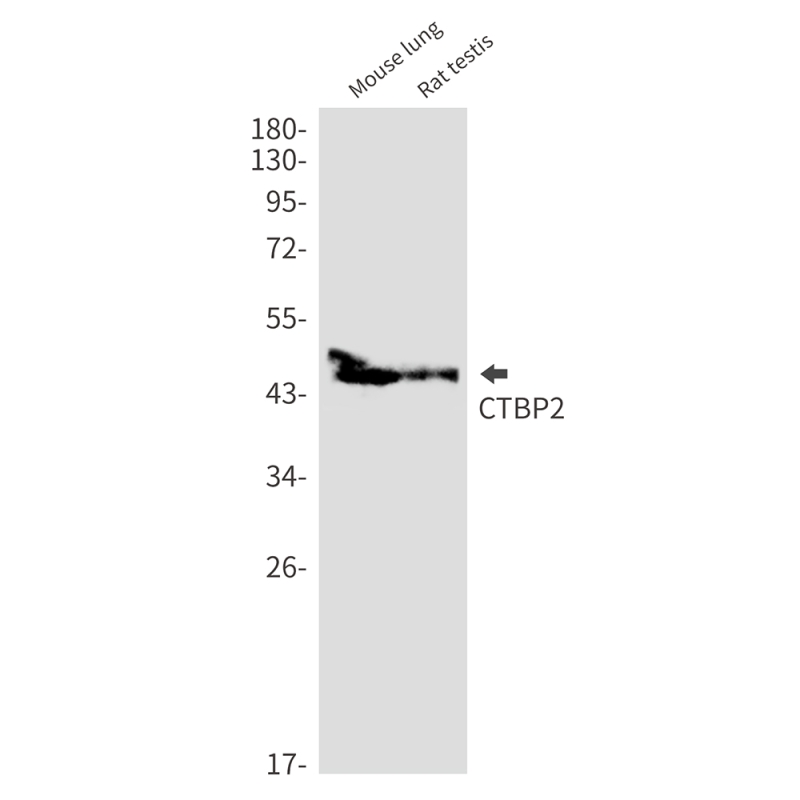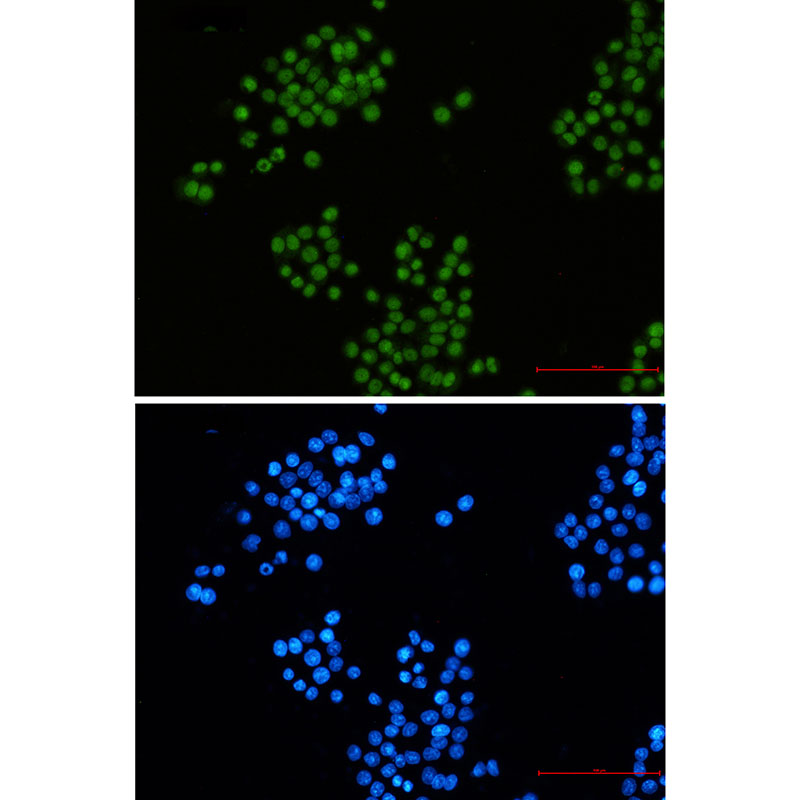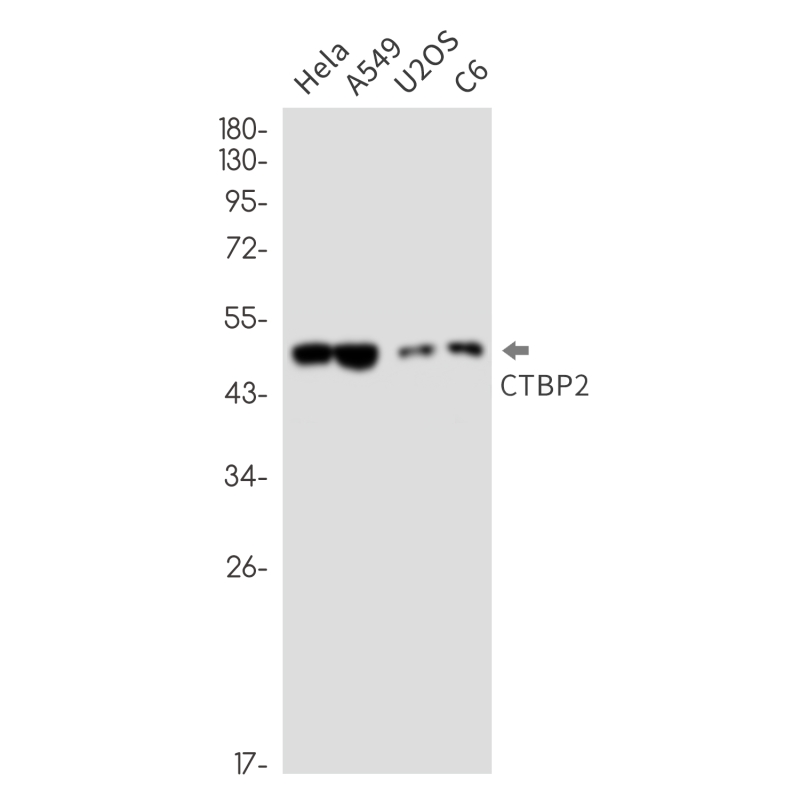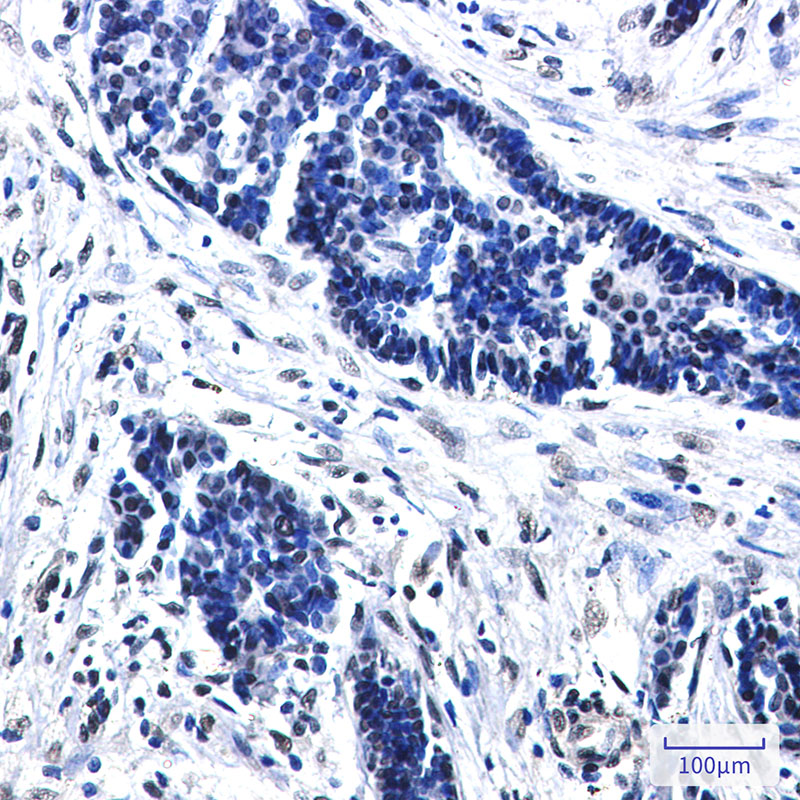



| WB | 1/500-1/1000 | Human,Mouse,Rat |
| IF | 咨询技术 | Human,Mouse,Rat |
| IHC | 1/50-1/100 | Human,Mouse,Rat |
| ICC | 1/50-1/200 | Human,Mouse,Rat |
| FCM | 咨询技术 | Human,Mouse,Rat |
| Elisa | 咨询技术 | Human,Mouse,Rat |
| Aliases | C-terminal-binding protein 2 |
| Entrez GeneID | 1488 |
| WB Predicted band size | Calculated MW: 49 kDa; Observed MW: 49 kDa |
| Host/Isotype | Rabbit IgG |
| Antibody Type | Primary antibody |
| Storage | Store at 4°C short term. Aliquot and store at -20°C long term. Avoid freeze/thaw cycles. |
| Species Reactivity | Human,Mouse,Rat |
| Immunogen | A synthetic peptide of human CTBP2 |
| Formulation | Purified antibody in TBS with 0.05% sodium azide,0.05%BSA and 50% glycerol. |
+ +
以下是3篇关于CTBP2抗体的参考文献,涵盖不同研究应用:
1. **文献名称**: "CtBP represses p300-mediated transcriptional activation by direct association with its bromodomain"
**作者**: Chinnadurai G, et al.
**摘要**: 使用CTBP2抗体进行免疫共沉淀(Co-IP)和Western blot分析,揭示CtBP2通过结合p300的溴结构域抑制组蛋白乙酰化,从而调控基因转录。
2. **文献名称**: "CTBP2 overexpression is associated with poor prognosis in gastric cancer patients"
**作者**: Wang L, Zhang Y.
**摘要**: 通过免疫组化(IHC)和Western blot,利用CTBP2抗体检测胃癌组织中CTBP2蛋白高表达,发现其与患者生存率下降显著相关,提示其作为预后标志物的潜力。
3. **文献名称**: "CtBP2 interacts with BRCA1 to regulate homologous recombination repair"
**作者**: Turner DP, et al.
**摘要**: 采用CTBP2抗体进行染色质免疫沉淀测序(ChIP-seq)和免疫荧光,证明CtBP2与BRCA1相互作用,影响DNA同源重组修复功能,为癌症治疗提供新靶点。
4. **文献名称**: "CTBP2 promotes tumor progression and stemness in triple-negative breast cancer"
**作者**: Li H, et al.
**摘要**: 结合shRNA敲低和CTBP2抗体的Western blot/免疫荧光实验,证实CTBP2通过激活Wnt/β-catenin信号通路增强三阴性乳腺癌的干性和转移能力。
这些研究展示了CTBP2抗体在蛋白质相互作用分析、临床预后评估、DNA修复机制及癌症干细胞研究中的关键作用。
The C-terminal binding protein 2 (CTBP2) antibody is a tool used to detect CTBP2. a transcriptional co-repressor involved in gene regulation. CTBP2 belongs to the CTBP family, which includes CTBP1 and CTBP2. both sharing structural homology and functioning as coregulators of transcription. These proteins bind to the C-terminal region of adenovirus E1A oncoproteins and interact with chromatin-modifying complexes, such as histone deacetylases (HDACs) and methyltransferases, to repress target gene expression. CTBP2 plays critical roles in embryonic development, cell cycle regulation, apoptosis, and epithelial-mesenchymal transition (EMT). Dysregulation of CTBP2 is linked to cancer progression, metastasis, and therapeutic resistance, with overexpression observed in malignancies like breast, colorectal, and prostate cancers.
CTBP2 antibodies are widely used in research to assess protein expression levels and subcellular localization via techniques like Western blotting, immunohistochemistry (IHC), and immunofluorescence (IF). Specificity is crucial due to the high sequence similarity (~80%) between CTBP1 and CTBP2. requiring antibodies that distinguish isoform-unique epitopes. Studies leveraging CTBP2 antibodies have highlighted its role in cancer pathways, including interactions with Wnt/β-catenin signaling and hypoxia-inducible factors. These antibodies also aid in exploring CTBP2’s potential as a biomarker or therapeutic target. However, variability in antibody performance across experimental conditions underscores the need for validation using knockout controls or peptide blocking assays. Overall, CTBP2 antibodies remain vital for dissecting the protein’s multifaceted contributions to cellular processes and disease.
×